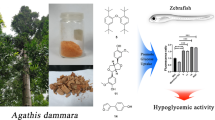Abstract
No anthelmintic sugars have yet been identified. Eight ketohexose stereoisomers (d- and l-forms of psicose, fructose, tagatose and sorbose), along with d-galactose and d-glucose, were examined for potency against L1 stage Caenorhabditis elegans fed Escherichia coli. Of the sugars, d-psicose specifically inhibited the motility, growth and reproductive maturity of the L1 stage. d-Psicose probably interferes with the nematode nutrition. The present results suggest that d-psicose, one of the rare sugars, is a potential anthelmintic.
Similar content being viewed by others
References
Mukai D, Matsuda N, Yoshioka Y, Sato M, Yamasaki T (2008) Potential anthelmintics: polyphenols of tea plant Camellia sinensis L. produce lethal toxicity in Caenorhabditis elegans. J Nat Med 62 (in press)
Kiuchi F, Tsuda Y, Yoshimura H, Nishioka I, Nonaka G (1998) Studies on crude drugs effective on visceral larva migrans. III. The bursting activity of tannins on dog roundworm larva. Chem Pharm Bull 36:1796–1802
Yamasaki T, Sato M, Mori T, Mohamed ASA, Fujii K, Tsukioka J (2002) Toxicity of tannins towards the free-living nematode Caenorhabditis elegans and the brine shrimp Artemia salina. J Nat Toxins 11:165–171
Goto I, Inaba M, Shimizu T, Maede Y (1994) Mechanism of hemolysis of canine erythrocytes induced by l-sorbose. Am J Vet Res 55:291–294
Masson S, Henriksen O, Stengaard A, Thomsen C, Quistorff B (1994) Hepatic metabolism during constant infusion of fructose; comparative studies with 31P-magnetic resonance spectroscopy in man and rats. Biochim Biophys Acta 1199:166–174
Buemann B, Gesmar H, Astrup A, Quistorff B (2000) Effects of oral d-tagatose, a stereoisomer of d-fructose, on liver metabolism in man as examined by 31P-magnetic resonance spectroscopy. Metabolism 49:1335–1339
Lewis JA, Fleming JT (1995) Basic culture methods. In: Epstein HF, Shakes DC (eds) Methods in cell biology 48. Caenorhabditis elegans: modern biological analysis of an organism. Academic Press, New York, pp 3–29
Hough L, Stacey BE (1963) The occurrence of d-ribohexulose in Itea ilicifolia, Itea virginica, and Itea yunnanensis. Phytochemistry 2:315–320
Schroeder W, Hoeksema H (1959) A new antibiotic, 6-amino-9-d-psicofuranosylpurine. J Am Chem Soc 81:1767–1768
Takeshita K, Suga A, Takada G, Izumori K (2000) Mass production of d-psicose from d-fructose by a continuous bioreactor system using immobilized d-tagatose 3-epimerase. J Biosci Bioeng 90:453–455
Itoh H, Izumori K (1996) Enzymatic production of l-tagatose and l-fructose from l-sorbose and l-psicose, respectively. J Ferment Bioeng 81:351–353
Muniruzzaman S, Tokunaga H, Izumori K (1995) Conversion of d-psicose to allitol by Enterobacter agglomerans strain 221e. J Ferment Bioeng 79:323–327
Takeshita K, Shimonishi T, Izumori K (1996) Production of l-psicose from allitol by Gluconobacter frateurii IFO 3254. J Ferment Bioeng 81:212–215
Muniruzzaman S, Tokunaga H, Izumori K (1994) Isolation of Enterobacter agglomerans strain 221e from soil, a potent d-tagatose producer from galactitol. J Ferment Bioeng 78:145–148
Itoh H, Sato T, Takeuchi T, Khan AR, Izumori K (1995) Preparation of d-sorbose from d-tagatose by immobilized d-tagatose 3-epimerase. J Ferment Bioeng 79:184–185
Kiuchi F, Miyashita N, Tsuda Y, Kondo K, Yoshimura H (1987) Studies on crude drugs effective on visceral larva migrans. I. Identification of larvicidal principles in betel nuts. Chem Pharm Bull 35:2880–2886
Fujiwara M, Sengpta P, McIntire SL (2002) Regulation of body size and behavioral state of C. elegans by sensory perception and the EGL-4 cGMP-dependent protein kinase. Neuron 36:1091–1102
Acknowledgments
The authors wish to thank Prof. Kazuhiro Fukada of Kagawa University for valuable discussions on this topic. This research was supported in part by a grant from the Glyco-Biocluster Plan Based on Rare Sugars of the Ministry of Education, Science, Sports and Culture of Japan.
Author information
Authors and Affiliations
Corresponding author
Rights and permissions
About this article
Cite this article
Sato, M., Kurose, H., Yamasaki, T. et al. Potential anthelmintic: d-psicose inhibits motility, growth and reproductive maturity of L1 larvae of Caenorhabditis elegans . J Nat Med 62, 244–246 (2008). https://doi.org/10.1007/s11418-007-0220-1
Received:
Accepted:
Published:
Issue Date:
DOI: https://doi.org/10.1007/s11418-007-0220-1




